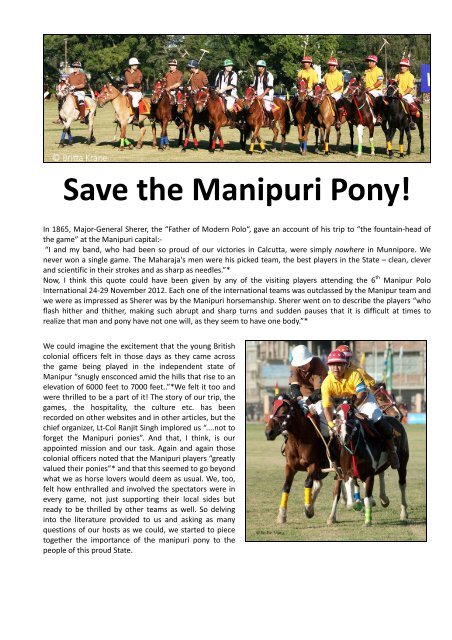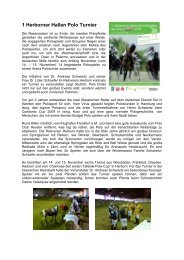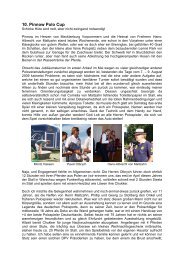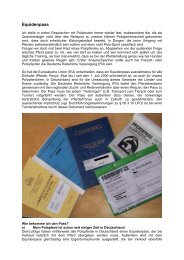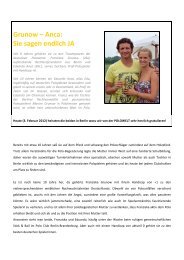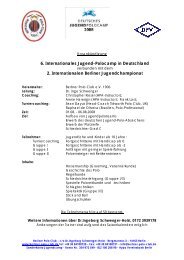You also want an ePaper? Increase the reach of your titles
YUMPU automatically turns print PDFs into web optimized ePapers that Google loves.
Save the Manipuri Pony!<br />
In 1865, Major‐General Sherer, the “Father of Modern Polo“, gave an account of his trip to “the fountain‐head of<br />
the game” at the Manipuri capital:‐<br />
“I and my band, who had been so proud of our victories in Calcutta, were simply nowhere in Munnipore. We<br />
never won a single game. The Maharaja's men were his picked team, the best players in the State – clean, clever<br />
and scientific in their strokes and as sharp as needles.”*<br />
Now, I think this quote could have been given by any of the visiting players attending the 6 th Manipur Polo<br />
International 24‐29 November 2012. Each one of the international teams was outclassed by the Manipur team and<br />
we were as impressed as Sherer was by the Manipuri horsemanship. Sherer went on to describe the players “who<br />
flash hither and thither, making such abrupt and sharp turns and sudden pauses that it is difficult at times to<br />
realize that man and pony have not one will, as they seem to have one body.”*<br />
We could imagine the excitement that the young British<br />
colonial officers felt in those days as they came across<br />
the game being played in the independent state of<br />
Manipur “snugly ensconced amid the hills that rise to an<br />
elevation of 6000 feet to 7000 feet..”*We felt it too and<br />
were thrilled to be a part of it! The story of our trip, the<br />
games, the hospitality, the culture etc. has been<br />
recorded on other websites and in other articles, but the<br />
chief organizer, Lt‐Col Ranjit Singh implored us “....not to<br />
forget the Manipuri ponies”. And that, I think, is our<br />
appointed mission and our task. Again and again those<br />
colonial officers noted that the Manipuri players “greatly<br />
valued their ponies”* and that this seemed to go beyond<br />
what we as horse lovers would deem as usual. We, too,<br />
felt how enthralled and involved the spectators were in<br />
every game, not just supporting their local sides but<br />
ready to be thrilled by other teams as well. So delving<br />
into the literature provided to us and asking as many<br />
questions of our hosts as we could, we started to piece<br />
together the importance of the manipuri pony to the<br />
people of this proud State.
This ancient civilisation, with evidence of a sedentary culture being found in Kangla dating around 15,000BC, sees<br />
the pony as “symbolizing the primal life source” and explains why the game of polo “has to be played with the<br />
utmost sanctity.”* We experienced this when one of the foreign players was gently but firmly reprimanded for<br />
clowning around on the field during a game. So the game should be played both passionately and seriously.<br />
The ponies we encountered were small (approx 13 hands) and again as Sherer describes, were “hardy, wiry and<br />
active, with blood‐like heads.” The owners had brought them in from the surrounding country ares where the<br />
ponies run free grazing on open grass lands. “This open feeding, living and grazing...have given the pony its surefootedness,<br />
sturdy and hardy physique, manoeuvrability and great stamina.”*<br />
However, it is this open living that is now contributing to the threatened extinction of the Manipuri pony. As the<br />
amount of open grazing diminishes due to the growth in the land's economic and agricultural value, the ponies are<br />
often left to fend for themselves and are threatened by private landowners, speeding vehicles, pollution, etc. We<br />
were told that the ponies would only eat fresh or freshly‐cut grass. (and we saw the deliveries of this at the polo<br />
field at Imphal) The option of feeding hay has been tried and has failed.<br />
The pony always had a sacred value in Manipur and never an economic one. It was used in war and polo was a<br />
means by which both man and pony could keep fit for battle, should the ruler require him. Nowadays, such<br />
motivation has, of course, disappeared. Later, too the rural population played the game as a leisure activity which<br />
didn't cost them a lot of money. This was not just restricted to the young men. We met women who had played<br />
the game as young girls growing up in the rural areas. But time marches on, even in Manipur, and today the<br />
young, educated Manipuri is looking for new thrills and new sports.<br />
Fortunately for the Manipuri pony, the Manipur Horse Riding and Polo Association has been formed and they have<br />
established the MHRPA Pony Breeding Farm about 30 minutes from the capital. This provides a home for the<br />
ponies and they have also started a breeding programme. The farm is becoming a place to visit, relax and bring<br />
tourists.<br />
Nicholas Colquhoun‐Denvers, former Chairman of the Hurlingham Polo Association has written in his message for<br />
the tournament programme, that he feels the modern polo world owes a great debt of gratitude to Manipur and<br />
to the Manipuri ponies. He praises the efforts made which give “hope for the future of this ancient breed of<br />
ponies.”<br />
Is there a way we could look at preserving these ponies not purely for historical reasons but to give them a status<br />
in this modern world? Could this preservation be part of an educational programme, not just for children of the<br />
area but nationally and internationally? Educationalists are in agreement that the work and play with horses can<br />
increase self‐esteem and confidence. These ponies with their forgiving temperament would be ideal for such a<br />
programme. Could the pony achieve a commercial status in some way? This is always a sure‐fired method to<br />
preserve a breed! There are, for sure, ideas out there. They would just have to be coordinated and implemented.<br />
This is beyond the scope of this article but as Lt Col Ranjit has said<br />
written by Jan‐Marie Kiesel January 2013<br />
“don't forget the Manipuri ponies!”<br />
Sources<br />
The Badminton Library of Sports and Pastimes edited by His Grace the Duke of Beaufort, K.G.<br />
Articles appearing in the Manipur Polo International Programme by:‐<br />
Chanam Hemchandra “Polo and Pony in Manipur”<br />
Nanjest Thongbam “Early Life and Space...Peopling, Pony and the Emergence of Polo in Manipur”<br />
Ch. Priyoranjan Singh “Polo Clubs and Players of Manipur”<br />
Lt Col. (Retd) M. Ranjit Singh “ Sagolkangjei (Polo) in the eyes of the British in 19 th Century”
Rechts: Lt. Col. Ranjit Singh gibt Gastspielern<br />
Erklärungen zum Zuchtprogramm<br />
Weitere Quellen: Wikipedia: http://en.wikipedia.org/wiki/Manipuri_Pony<br />
http://horseindian.com (und dort aufrufen: Horse Breed Standards / Manipuri Pony Breed Standard)<br />
http://www.youtube.com/watch?v=35M9d0xKuLQ


